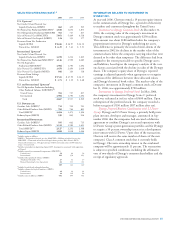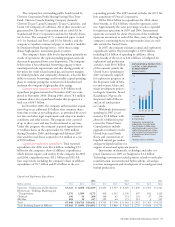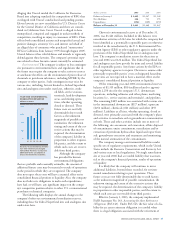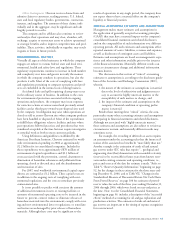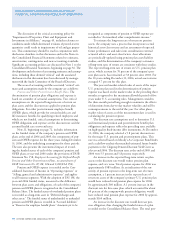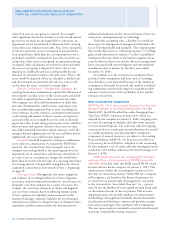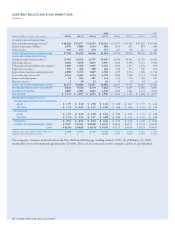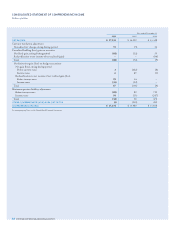Chevron 2006 Annual Report Download - page 44
Download and view the complete annual report
Please find page 44 of the 2006 Chevron annual report below. You can navigate through the pages in the report by either clicking on the pages listed below, or by using the keyword search tool below to find specific information within the annual report.
MANAGEMENT’S DISCUSSION AND ANALYSIS OF
FINANCIAL CONDITION AND RESULTS OF OPERATIONS
42 CHEVRON CORPORATION 2006 ANNUAL REPORT
long-lived assets and the liability can be reasonably estimated.
The liability balance of approximately $5.8 billion for asset
retirement obligations at year-end 2006 related primarily to
upstream and mining properties. Refer to Note 24 on page 82
for a discussion of the company’s asset retirement obligations.
For the company’s other ongoing operating assets, such as
refi neries and chemicals facilities, no provisions are made for
exit or cleanup costs that may be required when such assets
reach the end of their useful lives unless a decision to sell or
otherwise abandon the facility has been made, as the inde-
terminate settlement dates for the asset retirements prevent
estimation of the fair value of the asset retirement obligation.
Refer also to Note 24, on page 82, related to FAS 143 and
the company’s adoption in 2005 of FASB Interpretation No.
(FIN) 47, Accounting for Conditional Asset Retirement Obliga-
tions – An Interpretation of FASB Statement No. 143 (FIN 47),
and the discussion of “Environmental Matters” on page 43.
Income Taxes The company calculates its income tax
expense and liabilities quarterly. These liabilities generally
are not fi nalized with the individual taxing authorities until
several years after the end of the annual period for which
income taxes have been calculated. The U.S. federal income
tax liabilities have been settled through 1996 for Chevron
Corporation, 1997 for Unocal Corporation (Unocal) and 2001
for Texaco Corporation (Texaco). California franchise tax lia-
bilities have been settled through 1991 for Chevron, 1998 for
Unocal and 1987 for Texaco. Settlement of open tax years, as
well as tax issues in other countries where the company con-
ducts its businesses, is not expected to have a material effect on
the consolidated fi nancial position or liquidity of the company
and, in the opinion of management, adequate provision has
been made for income and franchise taxes for all years under
examination or subject to future examination.
Global Operations Chevron and its affi liates conduct
business activities in approximately 180 countries. Besides the
United States, the company and its affi liates have signifi cant
operations in the following countries: Angola, Argentina,
Australia, Azerbaijan, Bangladesh, Brazil, Cambodia, Can-
ada, Chad, China, Colombia, Democratic Republic of the
Congo, Denmark, France, India, Indonesia, Kazakhstan,
Myanmar, the Netherlands, Nigeria, Norway, the Partitioned
Neutral Zone between Kuwait and Saudi Arabia, the Phil-
ippines, Republic of the Congo, Singapore, South Africa,
South Korea, Thailand, Trinidad and Tobago, the United
Kingdom, Venezuela, and Vietnam.
The company’s operations, particularly exploration and
production, can be affected by changing economic, regula-
tory and political environments in the various countries
in which it operates, including the United States. As has
occurred in the past, actions could be taken by governments
to increase public ownership of the company’s partially or
wholly owned businesses or assets or to impose additional
taxes or royalties on the company’s operations or both.
In certain locations, governments have imposed restric-
tions, controls and taxes, and in others, political conditions
have existed that may threaten the safety of employees and
the company’s continued presence in those countries. Inter-
nal unrest, acts of violence or strained relations between a
government and the company or other governments may
affect the company’s operations. Those developments have
at times signifi cantly affected the company’s related opera-
tions and results and are carefully considered by management
when evaluating the level of current and future activity in
such countries.
Suspended Wells The company suspends the costs of
exploratory wells pending a fi nal determination of the com-
mercial potential of the related crude oil and natural gas
fi elds. The ultimate disposition of these well costs is depen-
dent on the results of future drilling activity or development
decisions or both. At December 31, 2006, the company had
approximately $1.2 billion of suspended exploratory wells
included in properties, plant and equipment, an increase of
$130 million from 2005 and an increase of $568 million
from 2004. More than $300 million of suspended wells were
added at the time of the Unocal acquisition in August 2005.
The future trend of the company’s exploration expenses
can be affected by amounts associated with well write-offs,
including wells that had been previously suspended pend-
ing determination as to whether the well had found reserves
that could be classifi ed as proved. The effect on exploration
expenses in future periods of the $1.2 billion of suspended
wells at year-end 2006 is uncertain pending future activities,
including normal project evaluation and additional drilling.
Refer to Note 20, beginning on page 71, for additional
discussion of suspended wells.
Equity Redetermination For oil and gas producing
operations, ownership agreements may provide for periodic
reassessments of equity interests in estimated crude oil and
natural gas reserves. These activities, individually or together,
may result in gains or losses that could be material to earn-
ings in any given period. One such equity redetermination
process has been under way since 1996 for Chevron’s inter-
ests in four producing zones at the Naval Petroleum Reserve
at Elk Hills, California, for the time when the remaining
interests in these zones were owned by the U.S. Department
of Energy. A wide range remains for a possible net settle-
ment amount for the four zones. For this range of settlement,
Chevron estimates its maximum possible net before-tax
liability at approximately $200 million, and the possible
maximum net amount that could be owed to Chevron is
estimated at about $150 million. The timing of the settle-
ment and the exact amount within this range of estimates
are uncertain.





